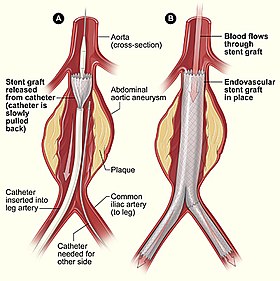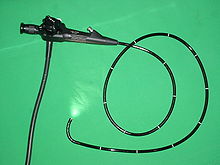Minimally invasive procedure
| Minimally invasive procedure | |
|---|---|
 Endovascular aneurysm repair - example of minimally invasive procedure | |
| MeSH | D019060 |
| eMedicine | 938198 |
Minimally invasive procedures (also known as minimally invasive surgeries) encompass
Interventional radiologists were the forerunners of minimally invasive procedures. Using imaging techniques, radiologists were able to direct interventional instruments through the body by way of catheters instead of the large incisions needed in traditional surgery. As a result, many conditions once requiring surgery can now be treated non-surgically.[2]
Diagnostic techniques that do not involve incisions, puncturing the skin, or the introduction of foreign objects or materials into the body are known as non-invasive procedures.[3] Several treatment procedures are classified as non-invasive. A major example of a non-invasive alternative treatment to surgery is radiation therapy, also called radiotherapy.[4]
Medical uses

Minimally invasive procedures were pioneered by
By use of a minimally invasive procedure, a patient may require only an
Specific procedures

Many medical procedures are called minimally invasive; those that involve small incisions through which an endoscope is inserted, end in the suffix -oscopy, such as
Equipment
Special
Benefits
Minimally invasive
Risks
Risks and complications of minimally invasive procedures are the same as for any other
There may be an increased risk of hypothermia and peritoneal trauma due to increased exposure to cold, dry gases during insufflation. The use of surgical humidification therapy, which is the use of heated and humidified CO2 for insufflation, may reduce this risk.[12]
Invasive procedures

Sometimes the use of non-invasive methods is not an option, so that the next level of minimally invasive techniques are looked to. These include the use of
Open surgery
"Open surgery" is any surgical procedure where the
See also
- Anesthesia
- ASA physical status classification system
- Medicine
- Natural orifice translumenal endoscopic surgery
- Traumatology
- Biomedical engineering
- Molecular imaging
- Venipuncture
References
- PMID 23684424.
- ^ doi:10.1016/j.jvir.2010.05.006. Archived from the original(PDF) on Jul 28, 2011.
- ISBN 978-1-4160-6257-8.
- ISBN 978-1-4160-6257-8.
- ^ "Minimally Invasive Surgical Procedures". MeSH - NCBI. Archived from the original on Sep 29, 2023.
- PMID 3121078.
- PMID 19735746.
- PMID 32619834.
- ISSN 2069-3850. 60. Archived from the originalon 2016-04-02. Retrieved 2012-08-19.(webpage has a translation button)
- S2CID 23157051.
- ^ "Minimally Invasive Surgery. Keyhole Surgery information". patient.info. Retrieved 2017-05-25.
- PMID 18639246.
Further reading
- "Minimally Invasive Cancer Treatments Highlighted". www.sciencedaily.com. November 28, 2005. Retrieved 2015-08-03.
- Tachibana K (March 2004). "Emerging technologies in therapeutic ultrasound: thermal ablation to gene delivery". Human Cell. 17 (1): 7–15. S2CID 19482620.
- Kim PE, Singh M (July 2003). "Functional magnetic resonance imaging for brain mapping in neurosurgery". Neurosurgical Focus. 15 (1): E1. PMID 15355003.
- Richie RC (2002). "Non-invasive assessment of the risk of coronary heart disease". Journal of Insurance Medicine. 34 (1): 31–42. PMID 15303592.
- Golder W (June 2004). "Magnetic resonance spectroscopy in clinical oncology". Onkologie. 27 (3): 304–9. S2CID 20644834.
- Cherry SR (February 2004). "In vivo molecular and genomic imaging: new challenges for imaging physics". Physics in Medicine and Biology. 49 (3): R13–48. S2CID 250810092.
- Lymberis A, Olsson S (2003). "Intelligent biomedical clothing for personal health and disease management: state of the art and future vision". Telemedicine Journal and e-Health. 9 (4): 379–86. PMID 14980096.
- Söling A, Rainov NG (October 2003). "Bioluminescence imaging in vivo - application to cancer research". Expert Opinion on Biological Therapy. 3 (7): 1163–72. S2CID 28865110.
- Rohrscheib M, Robinson R, Eaton RP (September 2003). "Non-invasive glucose sensors and improved informatics--the future of diabetes management". Diabetes, Obesity & Metabolism. 5 (5): 280–4. S2CID 7192060.
- Jacobs AH, Winkeler A, Dittmar C, Hilker R, Heiss WD (2002). "Prospects of molecular imaging in neurology". Journal of Cellular Biochemistry. Supplement. 39: 98–109. S2CID 8618818.
- Malhi GS, Valenzuela M, Wen W, Sachdev P (February 2002). "Magnetic resonance spectroscopy and its applications in psychiatry". The Australian and New Zealand Journal of Psychiatry. 36 (1): 31–43. S2CID 15981685.
- Jacobs A, Heiss WD (April 2002). "Towards non-invasive imaging of HSV-1 vector-mediated gene expression by positron emission tomography". Veterinary Microbiology. 86 (1–2): 27–36. PMID 11888687.
- Leman JA, Morton CA (January 2002). "Photodynamic therapy: applications in dermatology". Expert Opinion on Biological Therapy. 2 (1): 45–53. S2CID 40893453.
- Richter JE (November 1997). "Ambulatory esophageal pH monitoring". The American Journal of Medicine. 103 (5A): 130S–134S. PMID 9422638.
External links
- Minimally invasive heart surgery. Medical Encyclopedia, MedlinePlus.
